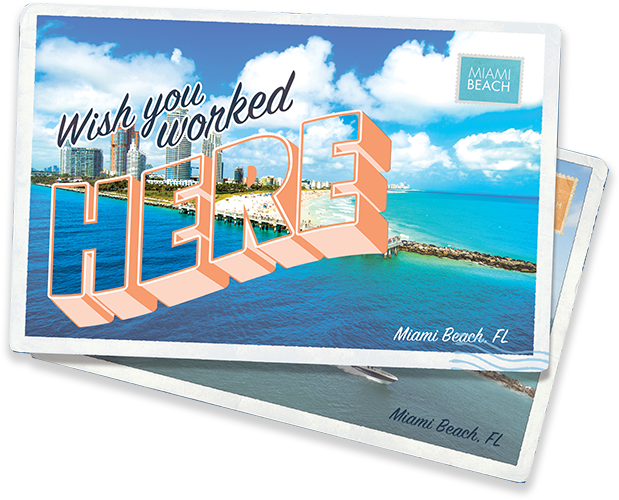
HR Recruitment
How To Apply
The City of Miami Beach is a vibrant, tropical, historic community and workplace like no other with job opportunities that encompass just about every industry and interest.
-

General Recruitment Process
The application process for employment with the City of Miami Beach varies depending upon the position. See individual job announcements by clicking on the links to the right of this section.
City of Miami Beach is an Equal Opportunity Employer. Applicants and employees are protected from discrimination based on certain categories protected by local and federal law.
The City of Miami Beach is a drug-free workplace.
Applicants must detail any related work experience on the application or risk disqualification. It is the applicant's responsibility to update their NEOGOV profile with work experience, education, certifications, and personal contact information when submitting each application. Failure to do so will result in ineligibility. The City of Miami Beach employees must disclose their current position and describe their internal work experience on the application to avoid disqualification.
Background testing is conducted on all successful candidates prior to employment.
-

Link to Job Opportunities
Opportunities
FAQs
The term Veteran means a person who served in the Unites States of America active military, naval, or air service and who was released with an Honorable discharge.
Individuals eligible for Veterans’ Preference (VP) are as follows:
- Disabled Veterans who have served on active duty in any branch of the Armed Forces and who presently have an existing service-connected disability that is compensable under public laws
administered by the Department of Veterans’ Affairs (DVA), or are receiving compensation, disability retirement benefits, or pension by reason of public laws administered by the DVA and the
Department of Defense (DoD). - The spouse of a Veteran:
a) Who has a total and permanent service-connected disability and who, because of this disability, cannot qualify for employment; or
b) Who is missing in action, captured in line of duty by a hostile force, or detained or interned in line of duty by a foreign government or power. - A Veteran of any war, who has served at least one day during that wartime period as defined in section 1.01(14), F.S., or who has been awarded a campaign or expeditionary medal. Active duty for training shall not be allowed for eligibility under this paragraph.
- The un-remarried widow or widower of a Veteran who died of a service-connected disability.
- The mother, father, legal guardian, or un-remarried widow or widower of a service member who died as a result of military service under combat-related conditions as verified by the DoD.
- A Veteran as defined in section 1.01(14), F.S. The term “Veteran” is defined as a person who served in the active military, naval, or air service and who was discharged or released there from under honorable conditions only or who later received an upgraded discharge under honorable conditions. “Active Duty for Training” does not qualify for VP.
- A current member of any reserve component of the United States Armed Forces or The Florida National Guard.
The Statutes and the Rules are applicable to Public entities such as the State and all their Agencies. They also apply to the State University System, State Community College System, the Florida School for the Deaf and Blind, and the State’s political subdivisions including counties, cities, towns, villages, special school districts, special road and bridge districts, bridge districts, and all other districts in the State.
The following list identifies positions that qualify:
Positions of employment offered by the State as designated in Section 295.07(4)(a), and listed below:
a) All positions under the state Career Service System.
b) All positions under the University Support Personnel System of the State University System.
c) All Career Service System positions under the Florida College System and the School for the Deaf and Blind.
d) Equivalent positions at State Universities, Florida College System institutions, or the School for the Deaf and Blind.
The following list identifies the positions that are exempt:
Positions of employment offered by the State as designated in Section 110.205(2), F.S and partially listed below (for a complete list see F.S.):
a) Persons employed on a temporary basis without benefits.
b) Heads of departments and certain managerial positions.
c) City managers, County managers, management and policymaking positions of political subdivisions of
the State.
d) All members of state boards and commissions.
e) Certain positions that require licensure as a physician.
f) Positions that require employee membership to the Florida Bar.
- World War II: December 7, 1941 - December 31, 1946.
- Korean Conflict: June 27, 1950 - January 31, 1955.
- Vietnam Era: February 28, 1961 - May 7, 1975.
- Persian Gulf War: August 2, 1990 - January 2, 1992.
- Operation Enduring Freedom: October 7, 2001 – ongoing.
- Operation Iraqi Freedom: March 19, 2003 - August 31, 2010.
- Operation New Dawn: September 1, 2010 – ongoing.
- Service during a campaign or expedition for which a campaign badge has been authorized.
A Veteran MUST have been discharged with nothing less than an “HONORABLE” discharge.
No, a General discharge is less than an Honorable discharge and does not qualify for Veterans’ Preference
To be eligible for VP an applicant must have one eligible period of active duty in which they received an Honorable discharge. Therefore, the applicant will be entitled to VP and the other DD Form 214 will be irrelevant.
A DD Form 215 is a document attached to a Veteran’s DD Form 214 which declares that some information contained on the DD Form 214 has been corrected, changed or added. This can include corrections to service dates and additions of medals. More importantly for our purposes, this can include upgrades to character of service. The change will supersede the previous one on the DD Form 214.
No, you do not have to be a Florida resident to qualify for VP.
No, any VP qualifying U.S. citizen or lawfully authorized alien worker in the United States can apply with a political entity in the State of Florida and request VP on their job application.
Eligible applicants can use VP as many times as they want when applying for initial hire positions. There is no expiration of VP, however, you must have qualifying service (90 consecutive days while in your civilian position) for internal promotions. If position is advertised externally, all VP eligible applicants can claim preference, even if it is a promotion for the veteran.
30% or more disabled veterans (except for veteran-only position) and when the decision to interview applicants is based on a non-numerical scoring system, all VP eligible applicants MUST be granted an interview.
Employers who use a numerically based system for hiring must augment a VP eligible applicant’s score. The amount that is awarded the applicant is based upon their eligibility category. The points/percentages are ten (10), fifteen (15), or twenty (20) and are allotted as follows:
- Disabled Veterans: 20 points/percent
- The spouse of a Veteran with a total and permanent service-connected disability, missing in action, captured in line of duty by a hostile force, or Detained or Interned in line of duty by a foreign government or power: 20 points/percent
- A Veteran of any war who has served at least one day during that wartime period or who has been awarded a campaign or expeditionary medal: 15 points/percent
- The un-remarried widow or widower of a Veteran who died of a service-connected disability: 15 points/percent
- The mother, father, legal guardian, or un-remarried widow or widower of a service member who died as a result of military service under combat-related conditions: 15 points/percent
- A Veteran as defined in section 1.01(14), F.S.:” The term ‘Veteran’ means a person who served in the active military, naval, or air service and who was discharged under honorable conditions: 10 points/percent
- A current member of any reserve component of the United States Armed Forces or The Florida National Guard: 10 points/percent
- After the applicant meets the required minimum qualifications for the position.
- After the applicant achieves a passing score on any required exams.
If a number system is used at ANY stage (ex: scoring KSAs, preferred qualifications, interviews) the score must be augmented to add Veterans’ Preference points.
VP is applied at every stage of the process. There are two ways of augmenting scores when there are multiple tests (as long as the minimum passing score is achieved at each stage):
- If the VP applicant earns a minimum passing score on an exam, their score is augmented with their eligible VP points and they are able to move forward to the next test where, if a minimum passing score is achieved, that score will also be augmented with their eligible VP points. This pattern continues through all tests toward a total score.
- An applicant takes a series of tests and all of their scores are added together to reach a single cumulative score. That score is then augmented with their VP-eligible points (as long as the minimum passing score is achieved at each stage).
If the total possible score during testing is 100 points, an applicant’s score should be augmented with 10, 15 or 20 points. If the total possible score is less than or more than 100 points, an applicant’s score should be augmented by 10%, 15% or 20% of the total possible score. For example, if the total possible score during testing is 50, an applicant who is a 10 point/percent Veteran, should have their score augmented by 10% of the 50 (total possible score) - in this particular example 5 points.
If there is a VP eligible applicant in the group, and all applicants are EQUAL, the decision maker MUST select the VP eligible applicant. The decision maker is not able to skip over a VP applicant and select an equally qualified non-VP applicant. If there is more than one VP applicant in the EQUALLY qualified group, the selection will be based upon how the applicants qualified for VP and their eligibility category. A qualifying disabled VP applicant will always be selected over any other category of applicants when EQUALLY qualified.
When an examination is not given, VP MUST be given at every step. At the very first step the VP eligible applicant, who meets the required minimum qualifications, is guaranteed an interview. However, the final selection of an applicant is based upon whom the decision maker believes is the most qualified applicant for a
position. If there are two VP candidates, who EQUALLY qualify, the selection shall be based upon how each candidate qualified for VP and their eligibility category. A qualifying disabled Veteran will always be selected over any other category of applicants when EQUALLY qualified. However, when a VP eligible applicant is NOT selected, an upper management individual, who has the authority to reverse the decision, MUST review the selected applicant and the VP eligible applicant(s) and determine if the most qualified person was chosen. Employers should document this review process.
- DD Form 214
a) Disabled Veterans shall also furnish a document from the DoD or the DVA establishing that the Veteran has a service-connected disability. The type of disability does not have to be disclosed in most cases. - Spouses of disabled Veterans shall furnish an Award Letter stating that they are entitled to benefits under Chapter 35 from the VA or the DoD. This confirms that the Veteran is totally and permanently disabled. The spouse should also have an identification card issued by the DoD; spouses shall also furnish a marriage certificate or other official evidence of marriage to the Veteran and a statement that the spouse is still married to the Veteran at the time of the application for employment.
- An un-remarried widow or widower of a Veteran who died of a service-connected disability shall supply documentation from the VA indicating the cause of death.
- Spouses of active duty member shall furnish the following documents:
a) DoD or DVA documentation certifying that the Veteran is listed as missing in action, captured in line of duty, or forcibly detained or interned in line of duty by a foreign government or power.
b) Evidence of marriage.
c) Statement that the spouse is married to the Veteran on active duty at the time of application for employment. - The mother, father, legal guardian, or un-remarried widow or widower of a deceased Veteran shall furnish a document from the DoD showing the death of service member while on-duty status under combat-related conditions or the DVA certifying the service-connected death of the Veteran, and shall further furnish evidence of marriage. The legal guardian shall show the court documents establishing the Guardianship.
- Current Reserve members and National Guard members should provide a signed memorandum from their military supervisor confirming their Active status in the Reserves or Guard.
If any of these documents are missing during the application process, the employer must let the veteran know what is missing by email and give the applicant 5 business days to cure the deficiency.


 83°
83° 